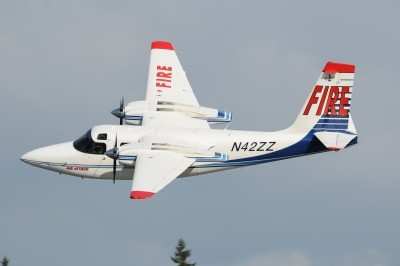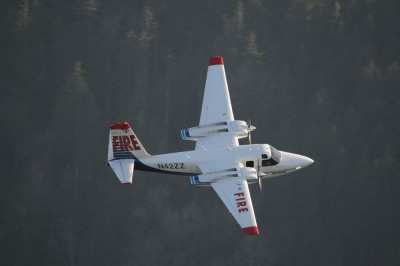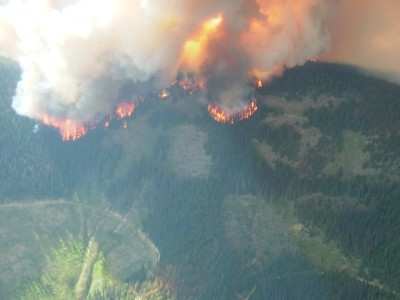Brad Goldman Uses His Airplane In "Command And Control"
Role
Summer is wildfire season, especially in the west, where a fleet
of general aviation aircraft are under contract to various state
and federal agencies to help battle the raging blazes. One make
that is popular among these aerial firefighters is Twin Commander.
Of the estimated 79 Twin Commanders in various government service
roles, many function as wildfire command and control aircraft.

Brad Goldman has been fighting fires for most of his adult life.
It's his passion, and for the past nearly 30 years his job, too ...
he's with Snohomish County Fire District 7, in Washington state
north of Seattle. Some 25 years ago he learned to fly, and it, too,
became a passion. Which explains Goldman's summer job: fighting
fires from the air. Goldman owns and operates Gold Aero, Inc.,
based in Arlington, Washington. His two-airplane fleet—a
Cessna 205 and Twin Commander 500S Shrike—function as aerial
supervision aircraft over large wildland fires. An air attack
supervisor in the airplane controls the airspace over the fire, and
makes tactical decisions on what type of aerial resources are
needed to support the ground crews battling the blaze.
Air attack aircraft serve a critical function in the high-stakes
effort to contain raging, fastmoving wildfires. Goldman founded the
business 11 years ago with the Cessna. A few years later he heard
that his primary customer, the U.S. Forest Service, was going to
require that its contractors fly only multiengine aircraft, so he
began to research the options. A high wing is an obvious attribute
given the need for good all-around visibility on an air attack
aircraft. That narrowed the choices down to the centerline-thrust
Cessna 337 Skymaster; the Partenavia, a fixed-gear piston twin
built in Italy; and Twin Commanders.

He asked air attack supervisors for their preferences.
“Most said that their first choice is a Twin
Commander,” Goldman said.“The only thing I knew about
Twin Commanders was that Bob Hoover flew one. So I started learning
about them.” That effort lasted two years, and eventually led
him to San Jose, California, where he found the second-to-last
Shrike Commander that Rockwell built. Although it had only 3500
hours on the airframe, it was nowhere near ready for active duty
fighting wildfires. In fact, it was already well into retirement.
The engines, props, and landing gear all needed overhauling; the
avionics were outdated; and the paint was oxidized.
Goldman bought it. “We spent a full year-plus going
completely through the airplane, making it better than new,”
he explained. “It was a lot of work, but now it's a good
airplane, very reliable.” Most important, “the Forest
Service folks really enjoy flying in it,” Goldman added.

Brad Goldman With His Twin Commander
Last year was the Commander's first full season as an air attack
aircraft. A typical mission has the pilots reporting for duty early
in the morning at a temporary base for the airplanes and
helicopters involved in battling a blaze. All pilots attend a
briefing to review weather forecasts, the status of the fire and
its predicted “behavior,” safety issues, and the plans
and objectives for the day. Then it's time to preflight the
aircraft, meet up with the air attack supervisor who will be in the
right seat and possibly a traineeobserver, and launch. “We're
usually the first one over the fire,” Goldman explained.
“We look for changes in the fire lines that occurred
overnight, and relay that information to the fire bosses on the
ground.” The air attack supervisor also communicates with
crews on ground who have just arrived on scene, and calls in other
ground-based resources. All this while directing tanker
aircraft and making sure no uninvited airplanes jeopardize
safety.
The air attack supervisor also monitors flight times of each
aircraft to ensure they have adequate fuel for the mission, and
calls in replacements to allow for refueling. The objective is to
avoid any gaps in the firefighting effort. The Gold Aero Commander
has long-range tanks (223 gallons), but Goldman said they
don’t usually depart with full fuel. That's because they
typically fly for about four hours at a time, and most of that
is spent loitering over the blaze with the power set at 16
inches MP and 2200 rpm for reduced fuel flows. The aircraft is
equipped with a fuel totalizer and engine analyzer.

Most days they fly one sortie in the morning and one in the
afternoon, for a total of eight hours. “If it's a big fire we
use two air attack aircraft,” Goldman explained,
“with one flying in relief.” The Commander does not
have air-conditioning. “I’m flying Forest Service guys
around who are pretty tough,” Goldman said. “But
there's enough air flow in the cockpit when we're flying
two-to-three-thousand feet over the fire.”
Sometimes there's smoke in the cockpit as well. “That was
one of weirdest things I discovered when I started doing this ...
flying and smelling smoke, and it’s normal,” Goldman
said. “But it’s woodsmoke, not smoke from an electrical
or gasoline-fed fire. “You have to fly in smoke when you're
fighting fires, but if you can’t see through the smoke it's
not wise to fly through it,” he added, especially since
they're typically flying over hilly or mountainous terrain.
“What you want to avoid are the large thermals, large columns
of smoke. Most people have no concept of the power and energy in a
large fire. I've seen smoke columns from a fire go up to 35,000
feet. They make their own thunderstorms. I've seen tree limbs go
past the aircraft in a smoke column.”

Because they fly often in smoky conditions, Goldman changes air
filters every 50 hours and washes the aircraft frequently. Goldman
splits the air attack flying in the Commander with one other pilot.
“It's a real treat to fly the Commander,” he said.
“It's a solid, tough it gets a lot of attention. People look
at the airplane and ask questions about it.”
Goldman said he is happy with his decision to buy and refurbish
the Shrike. “The last tactical group supervisor I flew with
said it's the best air attack airplane he’s been in. It's
comfortable, and the visibility is outstanding. And if the customer
is happy, I’m tickled!”
 ANN's Daily Aero-Term (04.14.24): Maximum Authorized Altitude
ANN's Daily Aero-Term (04.14.24): Maximum Authorized Altitude ANN's Daily Aero-Linx (04.14.24)
ANN's Daily Aero-Linx (04.14.24) Classic Aero-TV: 'We're Surviving'-- Kyle Franklin Describes Airshow Life 2013
Classic Aero-TV: 'We're Surviving'-- Kyle Franklin Describes Airshow Life 2013 Aero-News: Quote of the Day (04.14.24)
Aero-News: Quote of the Day (04.14.24) Airborne 04.09.24: SnF24!, Piper-DeltaHawk!, Fisher Update, Junkers
Airborne 04.09.24: SnF24!, Piper-DeltaHawk!, Fisher Update, Junkers







